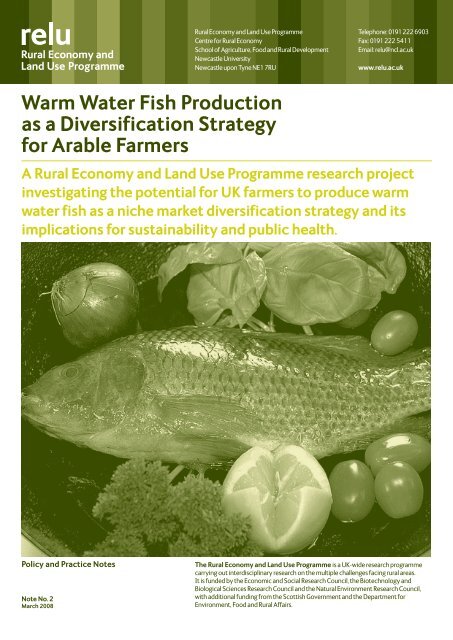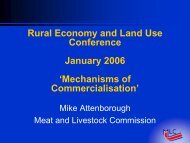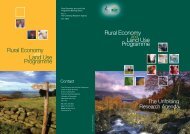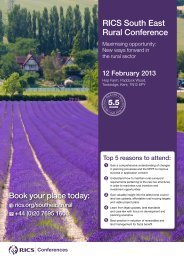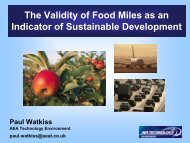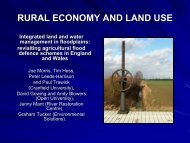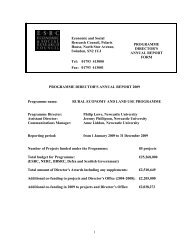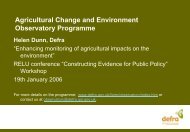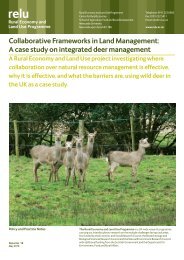Warm Water Fish Production as a Diversification Strategy for Arable ...
Warm Water Fish Production as a Diversification Strategy for Arable ...
Warm Water Fish Production as a Diversification Strategy for Arable ...
Create successful ePaper yourself
Turn your PDF publications into a flip-book with our unique Google optimized e-Paper software.
Rural Economy and Land Use Programme<br />
Centre <strong>for</strong> Rural Economy<br />
School of Agriculture, Food and Rural Development<br />
Newc<strong>as</strong>tle University<br />
Newc<strong>as</strong>tle upon Tyne NE1 7RU<br />
Telephone: 0191 222 6903<br />
Fax: 0191 222 5411<br />
Email: relu@ncl.ac.uk<br />
www.relu.ac.uk<br />
<strong>Warm</strong> <strong>Water</strong> <strong>Fish</strong> <strong>Production</strong><br />
<strong>as</strong> a <strong>Diversification</strong> <strong>Strategy</strong><br />
<strong>for</strong> <strong>Arable</strong> Farmers<br />
A Rural Economy and Land Use Programme research project<br />
investigating the potential <strong>for</strong> UK farmers to produce warm<br />
water fish <strong>as</strong> a niche market diversification strategy and its<br />
implications <strong>for</strong> sustainability and public health.<br />
Policy and Practice Notes<br />
Note No. 2<br />
March 2008<br />
The Rural Economy and Land Use Programme is a UK-wide research programme<br />
carrying out interdisciplinary research on the multiple challenges facing rural are<strong>as</strong>.<br />
It is funded by the Economic and Social Research Council, the Biotechnology and<br />
Biological Sciences Research Council and the Natural Environment Research Council,<br />
with additional funding from the Scottish Government and the Department <strong>for</strong><br />
Environment, Food and Rural Affairs.
Rural Economy and Land Use Programme<br />
<strong>Warm</strong> <strong>Water</strong> <strong>Fish</strong> <strong>Production</strong> <strong>as</strong> a <strong>Diversification</strong> <strong>Strategy</strong> <strong>for</strong> <strong>Arable</strong> Farmers<br />
The research explored the technical and marketing<br />
considerations surrounding the development of a small scale,<br />
warm water production system <strong>for</strong> growing the tropical fish<br />
tilapia <strong>as</strong> a diversification strategy <strong>for</strong> UK livestock and arable<br />
farmers. The system utilises on-farm resources and simplified<br />
technology which can be readily adopted <strong>as</strong> a sustainable and<br />
practical approach <strong>for</strong> farmers unfamiliar with fish production.<br />
The project explored niche market opportunities <strong>for</strong> tilapia,<br />
along with public health and sustainability implications, giving<br />
a better understanding of the challenges that face UK farmers.<br />
Why should farmers raise tilapia?<br />
<strong>Fish</strong> is being promoted <strong>as</strong> a healthy food but wild fish stocks<br />
are in decline and conventional fish farming in the UK h<strong>as</strong><br />
attracted criticism on environmental and welfare grounds.<br />
Tilapia h<strong>as</strong> been farmed throughout Europe over the l<strong>as</strong>t decade<br />
with varying success. Previous operations have been large scale,<br />
capital intensive commercial ventures often proving not to be<br />
viable. The research thus focussed upon a small scale, adaptive<br />
approach with lower initial risk but incorporating scope to scale<br />
up production over time <strong>as</strong> markets and husbandry skills were<br />
developed. <strong>Warm</strong> water fish also offer the prospect of a<br />
“greener” production system”.<br />
What are the technical implications?<br />
Farming tilapia may be daunting <strong>for</strong> the farmer who<br />
is inexperienced in this technology. The team looked<br />
at two systems currently in use: activated suspension<br />
technology (AST) which is b<strong>as</strong>ed on retention and<br />
reuse of nutrients within the production system,<br />
and recirculating aquaculture systems (RAS) which<br />
remove nutrients through external filtration.<br />
What are the environmental<br />
implications?<br />
<strong>Fish</strong> farming in the UK h<strong>as</strong> acquired a bad name in<br />
recent years on environmental grounds, but tilapia<br />
does not generally pose these kinds of problems.<br />
– Biosecurity risks are lower in on-land, enclosed systems<br />
where the fish cannot escape.<br />
– Tilapia do not migrate in the wild and thrive in dense groups<br />
so are well suited to this type of farming in welfare terms.<br />
– The energy costs to maintain required temperatures <strong>for</strong><br />
this warm water species are low. However, the energy<br />
required <strong>for</strong> operational purposes such <strong>as</strong> pumps and water<br />
engineering must be considered and must come from a<br />
reliable source <strong>as</strong> failure of the pumping system may be<br />
fatal <strong>for</strong> the fish.<br />
– Analysis of the ‘w<strong>as</strong>te’ or bacterial floc from both AST and<br />
RAS systems show that they could be useful <strong>as</strong> fertilizer.<br />
– Tilapia could be a “green”, high-welfare option<br />
<strong>for</strong> consumers.<br />
– Re-use of floc <strong>as</strong> fertiliser could add further<br />
sustainability and financial gains <strong>for</strong> small scale<br />
production of tilapia on UK farms.<br />
– AST systems, although offering some advantages in<br />
simplicity, potential <strong>for</strong> using locally grown feed and cost<br />
saving, were found to be less robust and efficient than the<br />
more conventional RAS <strong>for</strong> UK tilapia production.<br />
– Economic analysis concluded that AST is not currently a<br />
commercially viable option <strong>for</strong> UK farmers, although both<br />
systems produced fish that scored well in terms of t<strong>as</strong>te<br />
and welfare indicators.<br />
– A simplified, recirculating aquaculture system<br />
design is likely to be the more sustainable<br />
option <strong>for</strong> UK farmers with little prior experience<br />
in fish production.
Policy and Practice Notes<br />
Note No. 2 March 2008<br />
Who is likely to take up the option<br />
of producing tilapia?<br />
What markets could farmers exploit?<br />
Consideration of the markets is vital <strong>for</strong> potential<br />
producers of tilapia when taking a decision on<br />
whether to proceed with this investment.<br />
– Market testing indicates a demand <strong>for</strong> fresh, locally<br />
produced high quality tilapia. The products currently<br />
available tend to be imported and often frozen.<br />
– The relatively small scale of production will favour outlets<br />
catering <strong>for</strong> diners willing to pay higher prices <strong>for</strong> high<br />
quality, more unusual options. There<strong>for</strong>e ethnic and<br />
speciality restaurants, particularly those making a feature<br />
of fish dishes, fishmongers and fish markets in both rural<br />
and urban locations, and online fishmongers hold potential<br />
<strong>for</strong> locally produced, fresh tilapia.<br />
– Farmers markets and farm shops may also provide some<br />
scope to reach target consumers, but the requirements to<br />
build and maintain a customer b<strong>as</strong>e at farmers’ markets may<br />
be demanding <strong>for</strong> small producers.<br />
– Farm gate prices <strong>for</strong> domestically produced tilapia<br />
will vary greatly, depending on the market<br />
characteristics. This h<strong>as</strong> strong financial implications<br />
<strong>for</strong> the viability of the small scale production model,<br />
which is extremely price sensitive.<br />
– Farmers should invest time in seeking out and<br />
exploiting high value niche opportunities.<br />
– Supermarkets may provide a regular b<strong>as</strong>ic return <strong>for</strong><br />
growers, if they are producing at a large enough scale.<br />
– UK niche markets, primarily ethnic consumers, green<br />
and health conscious consumers and the higher<br />
priced end of the food service industry are likely to<br />
be the most fruitful.<br />
– Organic certification <strong>for</strong> tilapia <strong>as</strong> a means to adding<br />
value and attracting consumers is not <strong>as</strong> important<br />
<strong>as</strong> other indicators. Consumers and high-end food<br />
service operators are more interested in quality and<br />
freshness that local products can provide.<br />
The project identified a disparate range of<br />
motivational factors <strong>for</strong> engagement in diversification.<br />
At the core these spanned a continuum from “distress”<br />
to “success”, but also incorporated features such <strong>as</strong><br />
novelty, lifestyle, ideology and technical familiarity.<br />
– Although the researchers had envisaged mainstream farmers<br />
<strong>as</strong> the main target, this kind of novel diversification seems<br />
to be particularly attractive to entrepreneurs who want to<br />
move from urban to rural lifestyles.<br />
– Potential adopters who came <strong>for</strong>ward during the project<br />
tended to have a technical focus, with many barely<br />
considering marketing or post-harvest options.<br />
– Conversely the farmers who did consider marketing <strong>as</strong>pects<br />
to be of importance, tended to overlook the technical<br />
requirements and the health, safety and hygiene implications<br />
of post harvest activities.<br />
– Farmers need a rounded understanding of the<br />
factors involved in raising and marketing tilapia<br />
if they are to succeed.<br />
– The potential urban markets <strong>for</strong> tilapia, and the<br />
small area required to set up farms, also open up<br />
the potential <strong>for</strong> peri-urban developments.<br />
What motivates tilapia-b<strong>as</strong>ed<br />
diversification?<br />
Lifestyle<br />
Novelty<br />
Distress/Success<br />
Technical familiarity<br />
Regulatory<br />
Geographical: Urban Rural<br />
Ideology
Rural Economy and Land Use Programme<br />
<strong>Warm</strong> <strong>Water</strong> <strong>Fish</strong> <strong>Production</strong> <strong>as</strong> a <strong>Diversification</strong> <strong>Strategy</strong> <strong>for</strong> <strong>Arable</strong> Farmers<br />
What changes could help them to<br />
take up this option?<br />
No environmental health impact <strong>as</strong>sessments exist<br />
<strong>for</strong> farmed fish or indeed <strong>for</strong> fishing in the UK and<br />
beyond. Consumers need more in<strong>for</strong>mation about the<br />
potential health, <strong>as</strong> well <strong>as</strong> the environmental impacts<br />
of farming fish.<br />
– Consumers receive a lot of in<strong>for</strong>mation about healthy diets<br />
but this is often contradictory, particularly regarding what<br />
options are “green”. This applies to in<strong>for</strong>mation about the<br />
health benefits of eating fish and whether farmed fish can<br />
be a “green” option. Even different sorts of “eco-labelling”<br />
can be confusing.<br />
– Although the importance of multidisciplinary research<br />
h<strong>as</strong> been recognised, this needs to be followed through in<br />
government incentives and funding opportunities. For<br />
example SCORE (SME Collaborative Research) funding from<br />
the Scottish Government aims to encourage commercial<br />
and academic cooperation in research and development,<br />
yet is only concerned with production trials, without<br />
including the market <strong>as</strong>sessment which is a fundamental<br />
requirement <strong>for</strong> any commercial investment decision.<br />
– Data generated by this study provide a b<strong>as</strong>is <strong>for</strong><br />
developing environmental health and wider public<br />
health impact <strong>as</strong>sessment tools.<br />
– Consumers need to be more clearly and effectively<br />
in<strong>for</strong>med on the full spectrum of issues involved in<br />
farming and eating fish.<br />
– Research and development investment must<br />
include market analysis and <strong>as</strong>sessment<br />
of profitability<br />
Agricultural and fisheries policies are not integrated, which is<br />
problematic <strong>for</strong> grant funding, especially <strong>for</strong> onshore fish farming.<br />
– The policies applied to tilapia farming tend to be those of<br />
fisheries regulation when, in some instances, incorporation<br />
with agriculture could be more logical.<br />
– Currently, no agency is charged with responsibility <strong>for</strong><br />
providing comprehensive, validated and joined-up<br />
in<strong>for</strong>mation on land-b<strong>as</strong>ed fish production. This makes<br />
it difficult and time-consuming to access in<strong>for</strong>mation.<br />
Enquiries addressed to environmental and health agencies<br />
tend to result in piecemeal, often conflicting, answers<br />
that do not tend to promote enthusi<strong>as</strong>m <strong>for</strong> this type<br />
of diversification.<br />
– Agricultural and fisheries policies should<br />
be integrated to encourage this type of<br />
land-b<strong>as</strong>ed aquaculture.<br />
– There should be better and more joined-up<br />
provision of in<strong>for</strong>mation, with a single agency<br />
taking the lead.<br />
Is the research more widely<br />
applicable to diversification<br />
strategies?<br />
The research h<strong>as</strong> provided some evidence more widely<br />
applicable to novel diversification opportunities.<br />
– When making decisions regarding diversification options<br />
some farmers prefer a larger scale investment rather<br />
than an incremental approach even though this could<br />
reduce the risk.<br />
– Poor access to in<strong>for</strong>mation and an inadequate knowledge<br />
b<strong>as</strong>e restricts in<strong>for</strong>med decision making regarding<br />
diversification options.<br />
– There is potential <strong>for</strong> novel diversification that<br />
could be undertaken incrementally, alongside<br />
mainstream farming, and this could help to<br />
reduce risk.<br />
– More in<strong>for</strong>mation on the range of options available<br />
would be helpful <strong>for</strong> farmers.<br />
Further in<strong>for</strong>mation<br />
The research h<strong>as</strong> been carried out at<br />
the University of Stirling<br />
Key contact:<br />
Dr David Little, Institute of Aquaculture, University of Stirling,<br />
email: d.c.little@stir.ac.uk<br />
Useful resources:<br />
Project website:<br />
www.aqua.stir.ac.uk/Systems/tilapiaProject.htm


